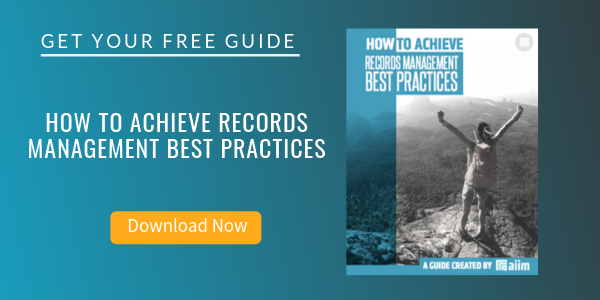
16 Electronic Records Management Stats to Benchmark Your Efforts Against
Electronic Records Management (ERM)
The findings from our latest research on Electronic Records Management (ERM) show that in most organizations, electronic records are still taken less seriously than paper records. Responsibility for applying good records management practice to electronic records would seem to reside in the IT department rather than in the records department, and even where good policies exist, they are often not monitored or enforced. Having said that, an encouraging number of organizations are homogenizing their electronic and physical policies and practices, and many are moving to an all-electronic model, linking their repositories together to improve the legal discovery process and enhance operational efficiency.
If you're wondering how your organization's ERM efforts stack up against others, here are sixteen stats to benchmark against:
- The volume of paper records is still increasing steadily in 56% of organizations, but in 22%, it's at last showing signs of decreasing. Meanwhile, the volume of electronic records is “increasing rapidly” for 70%, and unsurprisingly, it's not decreasing for any.
- Half of organizations are scanning newly received paper items and filing them electronically rather than manually, and a third of businesses are looking to go to all-electronic records-keeping.
- But for the other half, as well as manually filing inbound paper documents, 40% admit to routinely printing newly generated office documents and emails for the purpose of filing them as paper records.
- Electronic records are more than twice as likely to be described as “Unmanaged” than paper records.
- 71% of organizations have a procedure for legal hold of paper records in the event of litigation, but only 57% have one for electronic records.
- For 25% of organizations, legal discovery of paper records would take at least a month, whereas, for electronic records, this is 17%.
- There is a reliance on IT staff to carry out legal discovery on electronic records in the majority of companies, whereas records management staff or line-of-business staff deal with paper records.
- 13% of organizations are using dedicated e-discovery tools, and a further 22% are planning to do so. 42% are utilizing their ECM/ERM suites for e-discovery, and 12% are using Enterprise Search.
- Of those organizations with no ECM/ERM system, 60% would not be confident, if challenged, that their electronic records have not been changed, deleted, or inappropriately accessed.
- 38% of those polled admit that there is little or no enforcement of their records management policies, and 55% set no guidance on dealing with important emails as records.
- 31% of organizations have 20 or more content repositories that could usefully be linked, with email as the highest priority content.
- 35% are using in-house developed links to join up repositories, and a further 28% are using vendor custom-developed links. CMIS (Content Management Interoperability Services specification) has gained traction in just 15% of organizations as yet.
- Half of organizations would “possibly” store records in a local, identifiable outsource, but 77% state they would never use a public cloud (e.g., Google, Amazon, or Microsoft) even if they were assured of an onshore storage location. However, 67% would consider a corporate or government cloud.
- Two-thirds of organizations store a significant proportion of their records in native formats such as Word and Excel, although a third plan to converge to PDF-A over the next three years.
- Over 70% of organizations have made no plans or provisions for long-term archiving of electronic records, with no policies for migrating to new media, translating formats, or virtualization of applications.
- Spending on Records Management systems and modules is expected to be up overall in the next 12 months. Consultancy Services show a slight net fall.
About John Mancini
John Mancini is the President of Content Results, LLC and the Past President of AIIM. He is a well-known author, speaker, and advisor on information management, digital transformation and intelligent automation. John is a frequent keynote speaker and author of more than 30 eBooks on a variety of topics. He can be found on Twitter, LinkedIn and Facebook as jmancini77. Recent keynote topics include: The Stairway to Digital Transformation Navigating Disruptive Waters — 4 Things You Need to Know to Build Your Digital Transformation Strategy Getting Ahead of the Digital Transformation Curve Viewing Information Management Through a New Lens Digital Disruption: 6 Strategies to Avoid Being “Blockbustered” Specialties: Keynote speaker and writer on AI, RPA, intelligent Information Management, Intelligent Automation and Digital Transformation. Consensus-building with Boards to create strategic focus, action, and accountability. Extensive public speaking and public relations work Conversant and experienced in major technology issues and trends. Expert on inbound and content marketing, particularly in an association environment and on the Hubspot platform. John is a Phi Beta Kappa graduate of the College of William and Mary, and holds an M.A. in Public Policy from the Woodrow Wilson School at Princeton University.



